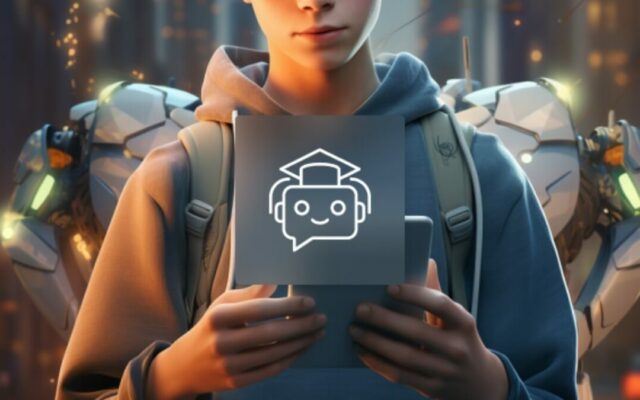How does a modern business capture and maintain the ever-elusive attention of potential customers? The answer lies in the strategic use of lead generation chatbots. These AI tools are boosting client acquisition, a cornerstone for any thriving enterprise. Among those embracing this technology, 55% report a significant rise in high-quality leads, a testament to the bots’ transformative impact.
In niche markets, these assistants achieve conversion rates of up to 70%, showcasing their effectiveness. More than just engaging prospects, they excel in segmenting audiences and delivering personalized product promotions. Thus bots can fuel a substantial portion of a company’s return on investment (ROI).
In the article, we’ll explore the mechanics and benefits of lead generation chatbots. Moreover, we will reveal how they differ from traditional methods and directly address the pressing challenges faced by enterprises today. With these insights, you’ll discover practical strategies to effectively harness the power of bots, elevating your prospect acquisition to new heights.
Table of Contents
Decoding Lead Generation Chatbots Definition: Functionality and Mechanics
Chatbots for lead generation, at their core, are AI-driven tools designed to automate and refine the process of acquiring potential customers. Integrated into digital platforms like websites, social media, and messaging apps, these bots are the first point of contact for many users. Their primary function is to engage visitors with interactive conversations. They provide a more dynamic and responsive user experience compared to static web forms.
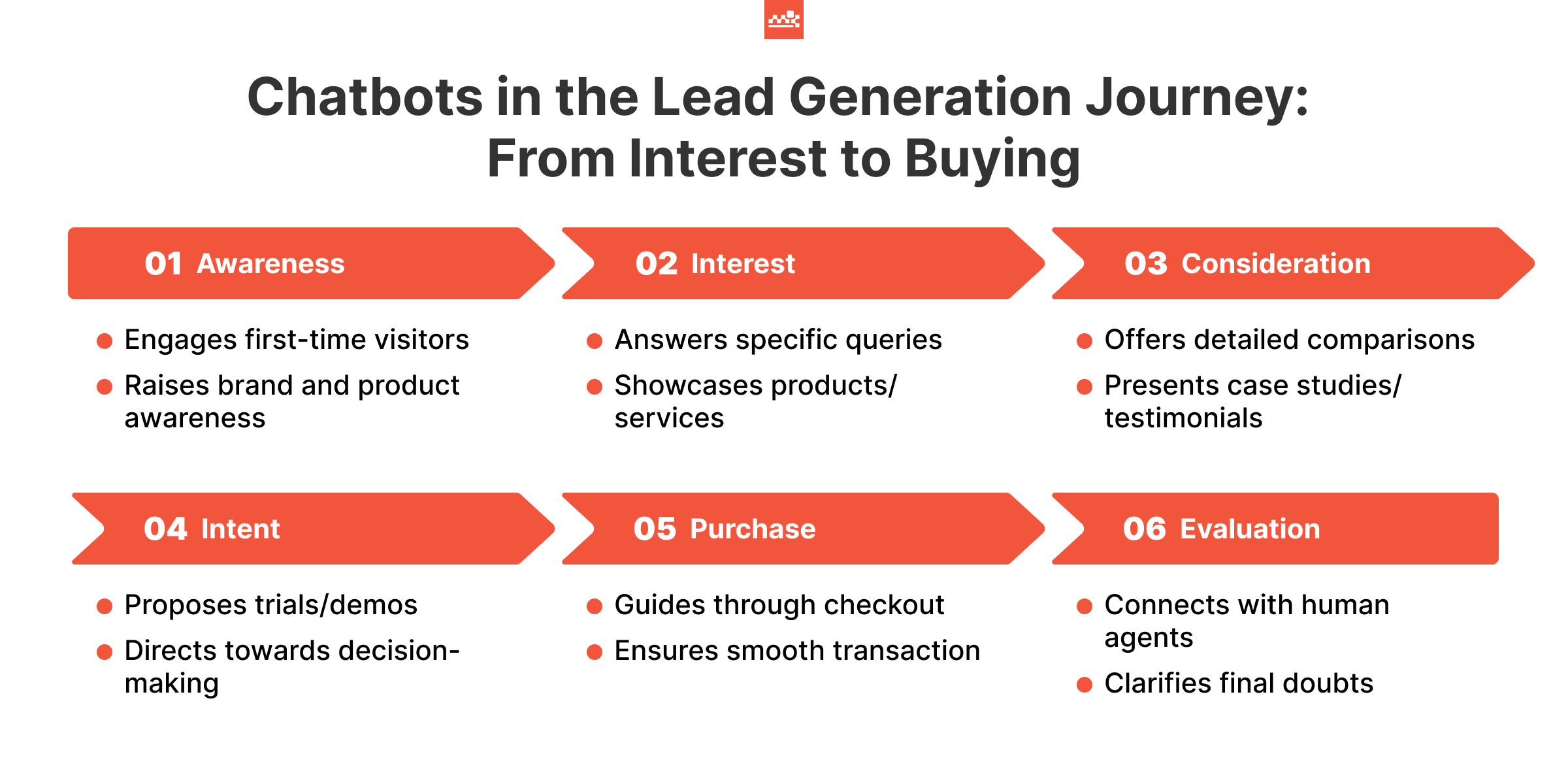
The process begins with chatbots initiating communication, often through automated greetings or contextually relevant prompts. Such a proactive engagement is key to capturing prospects’ attention. Once a conversation is initiated, the AI assistant employs a series of qualifying questions. These inquiries are strategically developed to filter and identify sales opportunities. Thus, bots determine users’ interests, needs, and readiness to interact with the company.
Personalization is another crucial aspect of the assistant’s functionality. By analyzing user input and browsing behavior, chatbots tailor their interactions. They offer more personalized and applicable information or product recommendations. This level of customization not only enhances the customer experience but also increases the likelihood of conversion, as buyers feel their specific demands are being addressed.
Furthermore, the tool excels in collecting and processing consumer data. This capability extends beyond mere conversation logs. They analyze dialogues to refine lead generation strategy and user engagement methods. The integration of AI bots with CRM systems is particularly beneficial. It allows for seamless transfer and management of clients’ details. The datasets exchange ensures that leads are not only captured but also effectively nurtured and passed on to the sales team for follow-up.
Overall, lead gen chatbots represent a significant advancement in digital marketing. Their ability to initiate contact, qualify leads, provide personalized interactions, and manage data efficiently makes them invaluable assets for businesses. As we continue to explore their benefits and use cases, it becomes increasingly clear how these tools are reshaping the landscape of customer acquisition.
Having discussed the inner workings of lead generation chatbots, let’s now compare them with traditional lead management methods to understand which works best in modern business environments.
Lead Management Chatbots vs Traditional Methods: A Business Perspective
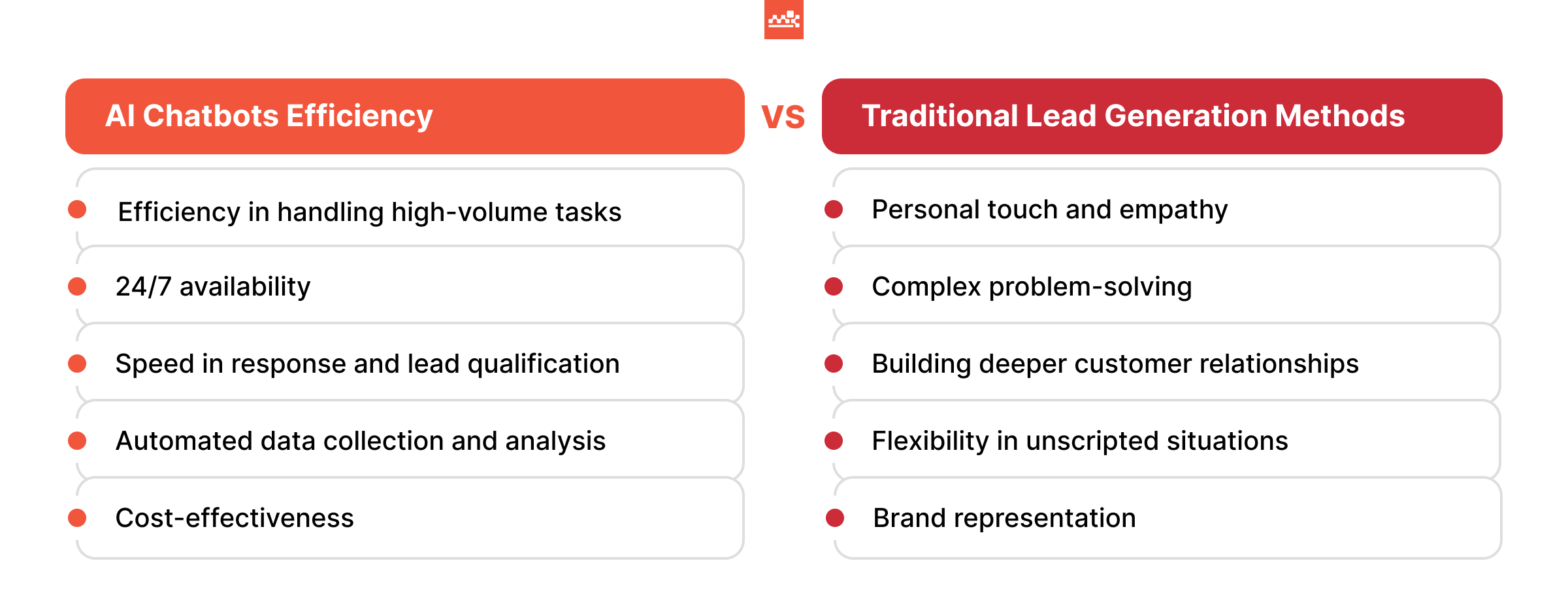
Traditional lead management strategies typically involve human interactions, such as phone calls, emails, and face-to-face meetings. They excel in offering a personal touch, building trust and rapport through human empathy. However, these conventional approaches also have limitations. They tend to be time-consuming and are often constrained by the availability of human resources. Particularly in sectors where the magnitude and speed of prospect engagement are elevated, these practices may struggle, leading to conceivable inefficiencies.
Lead generation chatbots, on the contrary, are effective in environments with high-volume communications. These assistants handle initial contacts and responses proficiently. They ensure that no potential client is overlooked, even outside of established business hours. The tools are adept at managing routine questions and qualifying leads, thereby saving resources. This makes bots an ideal solution for companies experiencing a large influx of inquiries or those aiming to expand their operations without a proportional increase in costs.
In combining chatbots for lead generation with traditional methods, enterprises create a synergistic prospect management framework. This hybrid model harnesses digital assistants for their quick processing and 24/7 availability. The focus is on efficiently handling high-volume tasks and initial inquiries. Simultaneously, it utilizes the human element for complex and sensitive interactions where emotional attention is key.
Such an approach ensures a balanced and comprehensive system. It optimizes the strengths of both components, delivering a nuanced service that addresses various aspects of the buyer journey. The strategy is especially beneficial for firms seeking to raise efficiency while maintaining quality customer relationships, thereby adapting to the diverse demands of the modern market.
From the comparison, it’s clear that AI bots are powerful tools with capabilities to substantially simplify the process of lead generation. So now let’s explore the specific pros they offer.
Maximizing Business Potential: The Advantages of Lead Generation Bots
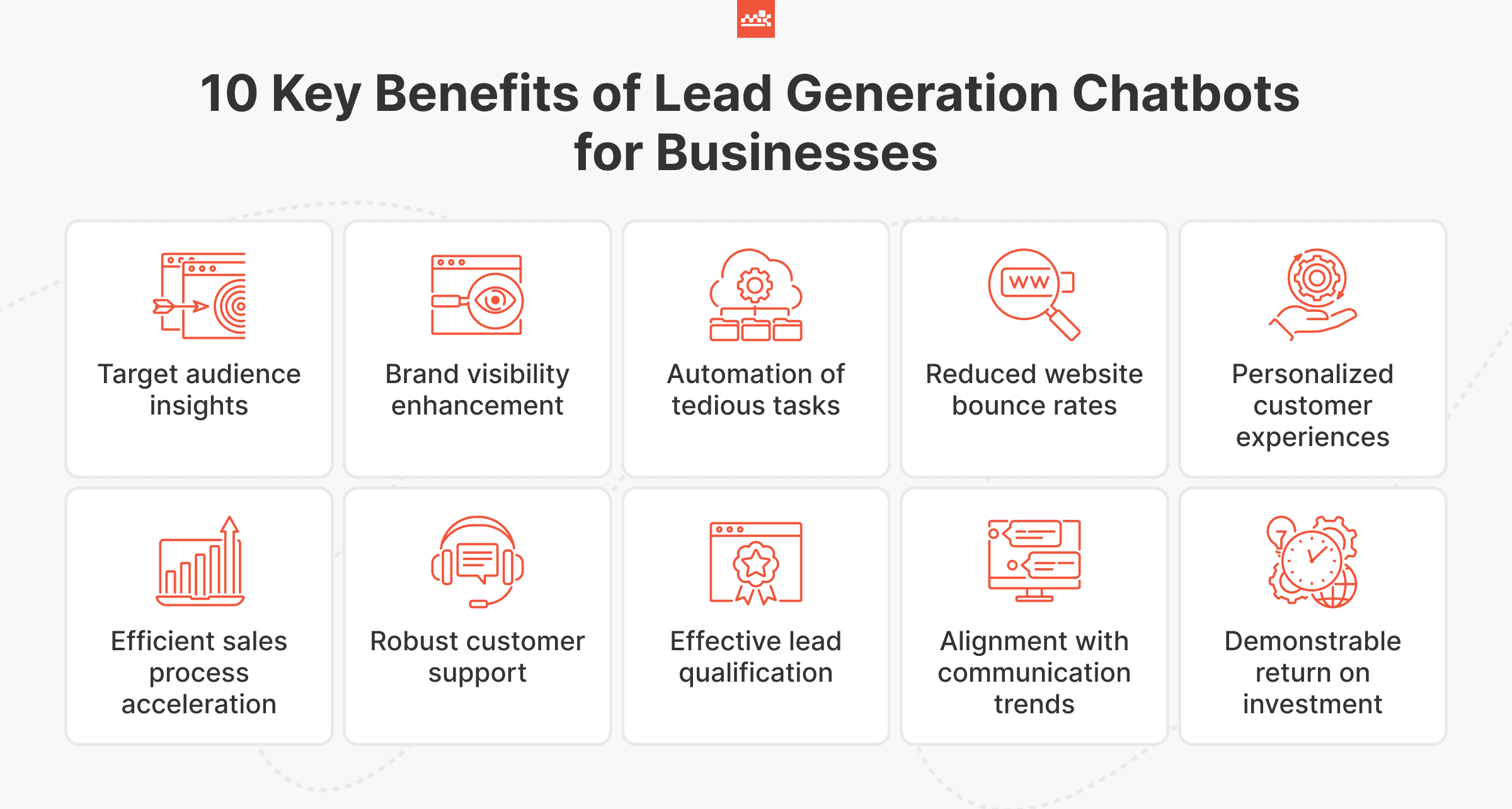
Digital assistants have become indispensable in enhancing business operations, offering a spectrum of benefits that redefine customer engagement and operational efficiency. Here’s a closer look at the key advantages of AI chatbots:
- Target audience insights. These bots for lead generation are adept at gathering details about your audience, analyzing interactions to fine-tune marketing strategies. Such deep understanding enables effective targeting and segmentation, ensuring sales efforts are more precisely aligned with consumer needs. Additionally, this data-driven approach aids in predicting future market trends and customer behaviors.
- Brand visibility enhancement. By deploying AI assistants, your trademark presence and reach are significantly enhanced across digital platforms. They engage users with consistent messaging, increasing recognition and loyalty among clients. Furthermore, the tool’s ability to provide immediate information reinforces brand authority and trust in the industry.
- Automation of tedious tasks and frequently asked questions. Companies implement an AI chatbot to answer FAQs and manage routine tasks like scheduling. Such optimization leads to increased productivity and allows staff to focus on creative and complex problem-solving. Moreover, it reduces the likelihood of human error in repetitive assignments.
- Reduced website bounce rates. AI lead generation chatbots engage visitors with interactive and relevant content. Their presence ensures that users find what they need quickly, raising satisfaction. The improved consumer experience directly translates into better engagement metrics and potentially higher conversion rates.
- Personalized customer experiences. AI digital assistants offer tailored approaches, adapting their conversations to individual profiles. Such customization fosters an engaging and satisfying buyer journey, boosting client retention. The tactic also helps in gathering more nuanced feedback, further refining the purchaser experience.
- Efficient sales process acceleration. Bots contact potential leads quickly and guide them efficiently through the selling cycle. The rapid communication reduces the lead-to-sale time, facilitating overall productivity. They also ensure that prospects are consistently nurtured, increasing the chances of conversion.
- Robust customer support. Providing round-the-clock immediate assistance, lead gen chatbots enhance service quality. Such reliability builds confidence and satisfaction among clients. They also help in reducing the workload on teams, allowing employees to focus on escalation cases.
- Effective lead qualification. The tools quickly identify and qualify potential buyers, streamlining the management process. This efficient assessment ensures that the sales team focuses on the most promising prospects. It also helps in customizing the deals, increasing the chances of successful conversions.
- Alignment with customer communication trends. Lead generation chatbots meet modern customers’ preferences for instant messaging, aligning with their requirements. Such practice guarantees that businesses are catering to the expectations of a tech-savvy client base. It also demonstrates a business’s commitment to staying current with technological advancements.
- Demonstrable ROI. Implementing AI chatbots for business results in a measurable return on investment. Their impact on various marketing and sales functions directly contributes to the financial health of the company. The benefits extend beyond economic aspects to encompass brand value and consumer loyalty.
Having explored the multitude of advantages, let’s now dive into real-world applications of chatbots for lead generation. We’ll reveal how these assistants are used across diverse industries for profitable business outcomes.
Lead Generation Chatbots in Action: Diverse Applications and Success Stories
Exploring AI chatbots use cases across niches showcases their incredible versatility and impact. From travel and automotive to fashion and dining, these tools have revolutionized customer engagement and sales strategies. Let’s delve into a few success stories to understand the full potential of digital assistants in action.
Travel Industry Conversion Boost: Luxury Escapes Chatbot
The Luxury Escapes Chatbot, crafted by Master of Code Global, upgraded the travel booking experience. Launched in 2019, it allowed users to find and book personalized premium trips. Moreover, the tool enhanced user engagement with a ‘Roll the Dice’ feature for vacation suggestions. The bot streamlined deal searches and reservation processes, providing more efficient journey planning.
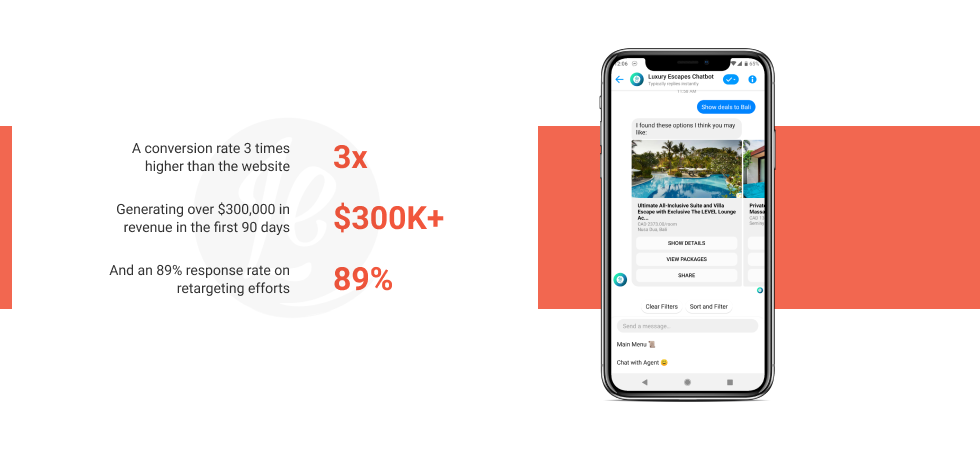
Remarkable results followed its launch:
- Over $300K in sales within the first 90 days;
- A 3x higher conversion rate compared to the website;
- Interactions with over 6,200 travelers in just 3 months;
- An impressive 89% reply ratio to retargeting messages.
Automotive Sales Enhancement: Feldman Facebook Chatbot
The Feldman Group Bot significantly boosted automobile sales for the Detroit-based dealership. This intelligent assistant, targeting potential car purchasers on Facebook, engaged them in conversations, leading clients through the buying process. It conversed using specific industry vocabulary making each dialogue meaningful and professional. Moreover, the tool included AI and natural language processing for better lead qualification. This case clearly illustrates how AI lead generation for car dealers enables continuous prospect capture, smarter qualification, and faster movement from first interaction to purchase.
Key achievements of the customer service chatbot include:
- Reaching nearly 100,000 people;
- Converting approximately 50 vehicle sales each month;
- Achieving click-through rates of 4.5 – 5%, nearly double the auto industry average.
Beauty Industry Appointment Booking: Aveda Chatbot
The Aveda Chatbot, created by Master of Code Global, transformed the reservation process for offers. It offered a guided buyer journey, enabling consumers to locate the nearest store, book services, and select preferred dates and times, all within the chat interface. This intuitive bot experience enhanced client engagement and attracted more prospects.
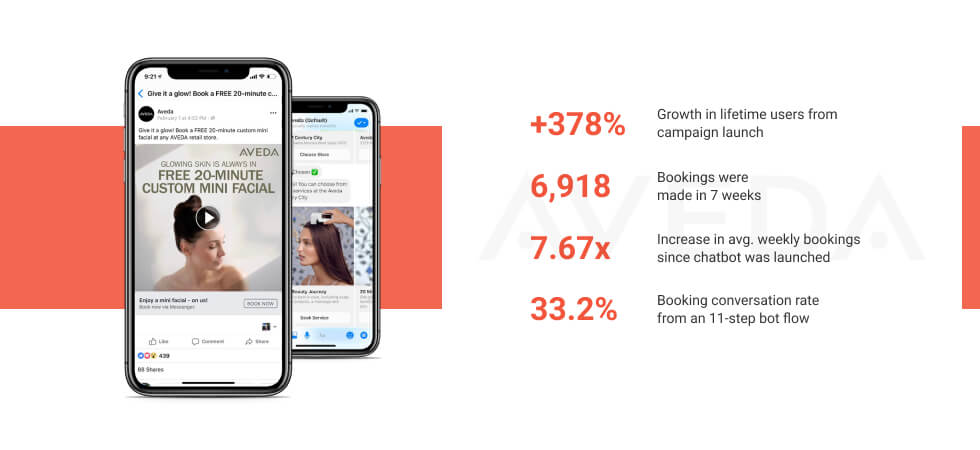
In just a seven-week period, the assistant demonstrated notable performance:
- A surge of 378% in lifetime users following the campaign’s launch;
- A notable 33.2% rise in the conversion ratio;
- A total of 6,918 additional bookings within this brief timeframe;
- An average weekly booking rate increased by 7.67 times.
Restaurant Industry Brand Promotion: Domino’s Tinder Bot
For Valentine’s Day, Domino’s Pizza launched ‘Dom Juan’, a chatbot posing as a regular profile. The app interacted with users who swiped right, offering playful lines to enhance their dating game. Such a unique strategy capitalized on Tinder’s popularity during this holiday, significantly boosting the company’s visibility and attracting more potential clients.
A few impressive accomplishments of the campaign:
- Achieved a 35x return on advertising spend;
- Led to a 10% increase in sales compared to the previous year;
- Generated over 2 million impressions on social media.
Fashion Retail Engagement: H&M Kik Bot
H&M’s Chatbot, an advanced AI tool in the fashion retail industry, offers an interactive shopping experience. It engages customers by asking about their style preferences and then recommends specific clothing items and complete outfits. This approach demonstrates how effectively chatbots for marketing can engage customers and promote products.
https://www.youtube.com/watch?v=zS4bRL7FXHA
Major results of the solution include:
- Achieved an impressive engagement rate of 86%.
- Maintained an average conversation duration of 4 minutes per user.
- Recorded an 8% click-through rate, outperforming email marketing rates by 6%.
- Significantly increased prospect engagement by 200%.
- Contributed to a substantial 70% increase in revenue.
As you can see, chatbots have demonstrated great potential in generating new leads, increasing sales, and boosting engagement. To capitalize on their capabilities, it’s vital to implement the tool carefully, considering various aspects. Let’s explore the recommendations gathered for you to maximize the benefits of AI assistants.
Best Practices for Lead Generation Chatbot Implementation
Imagine this: You’re looking to boost your sales, and you’ve heard about the potential of bots. But where do you start? Right here! Let’s dive into the guidelines for their integration, ensuring that these digital assistants are not just tools, but key players in the company’s growth strategy.
- Develop comprehensive buyer personas. Creating detailed profiles of your target audience allows for more precise and effective communication approaches. By understanding customer demographics, preferences, and behaviors, bots can tailor interactions to meet specific needs and interests.
- Implement tailored messaging strategies. This step involves shaping the dialogue to align with individual unique choices and history. By analyzing past exchanges, the AI assistant can engage in context-rich conversations that feel more intuitive and helpful. This bespoke approach fosters a deeper connection with each consumer, enriching their journey and igniting interest, leading to higher conversion rates.
- Enhance lead segmentation and profiling. Utilize chatbots to segment prospects based on their communications and actions effectively. This enables more targeted marketing efforts and guarantees that future purchasers receive content and offers that are most relevant to them.
- Adapt conversation tone dynamically. Adjusting the tone to suit the topic of the chat as the consumer’s mood is crucial for maintaining a positive interaction. This flexibility helps in building rapport and trust with users.
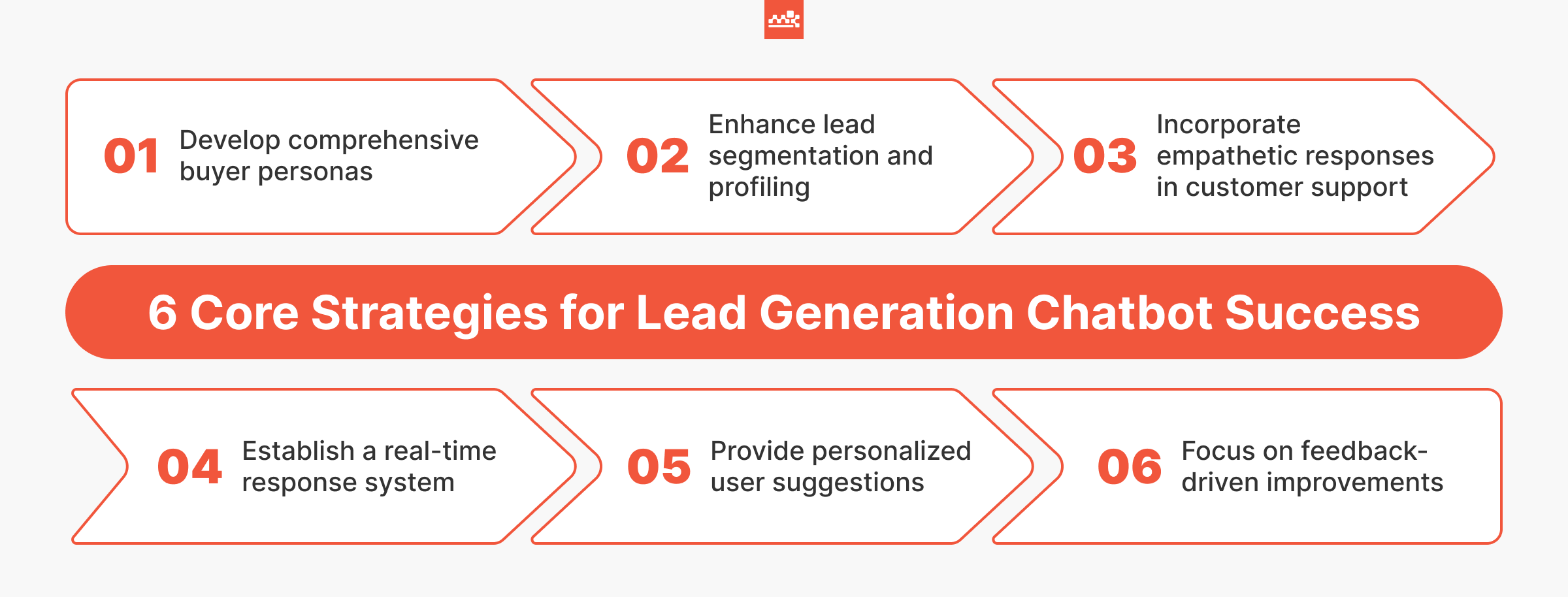
- Incorporate empathetic responses in customer support. Empathy in replies, especially in client care scenarios, can significantly elevate a shopper’s contentment. Programming bot solutions to understand and respond to user emotions appropriately is essential to compelling assistance.
- Establish a real-time response system. Instant answers from chatbots can greatly enrich buyer experience and engagement. An on-the-spot reply mechanism ensures prospect’s queries are addressed promptly, improving service efficiency.
- Craft engaging welcome messages. The initial conversation sets the tone for the entire purchaser journey. Creating entertaining and inviting greetings captivates one’s interest from the very beginning.
- Provide personalized user suggestions. By analyzing personal data and preferences, lead generation chatbots offer customized recommendations, guiding customers through the decision-making process in a more unique and constructive manner.
- Ensure transparent data collection practices. Maintaining transparency in how client information is collected and used builds trust. Clearly articulated statements on dataset management methods reassure buyers about their privacy and safety.
- Implement visitor retargeting strategies. Re-engaging users who have previously interacted with the tool is an effective strategy. Tailored remarketing established on past interactions leads to increased conversions.
- Enable multilingual communication. Offering support in multiple languages widens your reach and caters to a more diverse consumer base. This feature is particularly important for global businesses.
- Focus on feedback-driven improvements. Regularly updating and fine-tuning the AI bot based on user reviews make certain that the assistant evolves to meet changing shopper needs and tastes.
Implementing these best practices is the key to maximizing the potential of your lead generation chatbot. However, bringing these strategies to life requires a specialized touch. At Master of Code Global, we understand the pain points of our customers and are willing to help with resolving them. As an AI chatbot development company, we specialize in developing custom artificial intelligence solutions that align with your business necessities and goals.
Our team of experts ensures that your chatbot for lead generation not only meets but exceeds your expectations, providing advanced functionality and comprehensive support. We focus on creating tools that are scalable, flexible, and seamlessly integrated with your existing systems, all while maintaining your brand’s unique voice.
At Master of Code Global, we’re also at the forefront of Generative AI technology. This cutting-edge tech takes our bots to the next level, making them even smarter and more intuitive. Imagine your lead generation chatbot not just responding but also predicting and personalizing interactions in ways you never thought possible. This is the future of client acquisition, and we’re excited to foster the change. So, let’s move forward and delve into how exactly these emerging technologies are upgrading lead generation.
The Future of Lead Generation: Innovations with Generative AI

The realm of business development and acquiring new clients is on the cusp of a significant shift, thanks to Gen AI. This technology isn’t simply about automating responses; it’s about creating lead generation chatbots that can think, learn, and adapt. Imagine a bot that doesn’t just understand your customers’ needs but anticipates them, offering solutions before consumers even ask.
Recent advancements in AI have led to tools that can analyze dialogue patterns, predict user behavior, and customize replies in more sophisticated ways. They now engage buyers with a level of personalization that was once only possible in human interactions. AI bots process and learn from vast amounts of data, making them adept at identifying and nurturing potential leads.
The evolving landscape of lead generation lies in this blend of AI’s predictive capabilities and nuanced understanding of conversation. It’s not merely about responding to queries; it’s about forging connections. As AI continues to evolve, we can expect to see AI assistants becoming an even more integral part of prospect acquisition strategies.
Summing Up
In this guide, we’ve delved into the transformative power of lead generation chatbots, highlighting their ability to reshape client interactions and sales strategies. These AI tools offer more than just automated responses. They bring a level of sophistication and personalization that can enhance the buyer’s journey.
At Master of Code Global, we harness this potential to keep your business at the forefront of market trends as seen in the chatbot examples discussed. By partnering with us, you’ll embrace the future of online engagement with AI, setting new standards in customer communication and prospect attraction. Let’s collaborate to craft your success story in the digital landscape.
Discover how Master of Code Global can help enhance your customer’s experience and boost sales growth.






